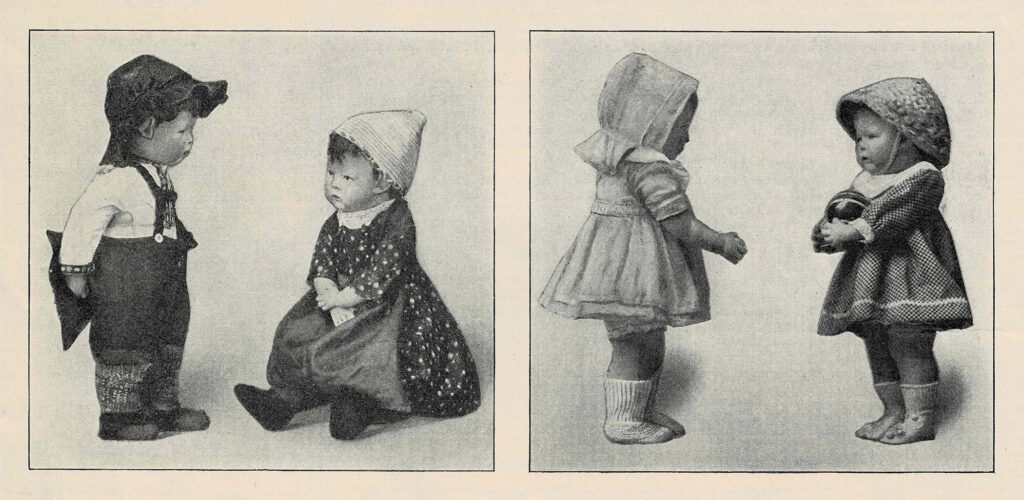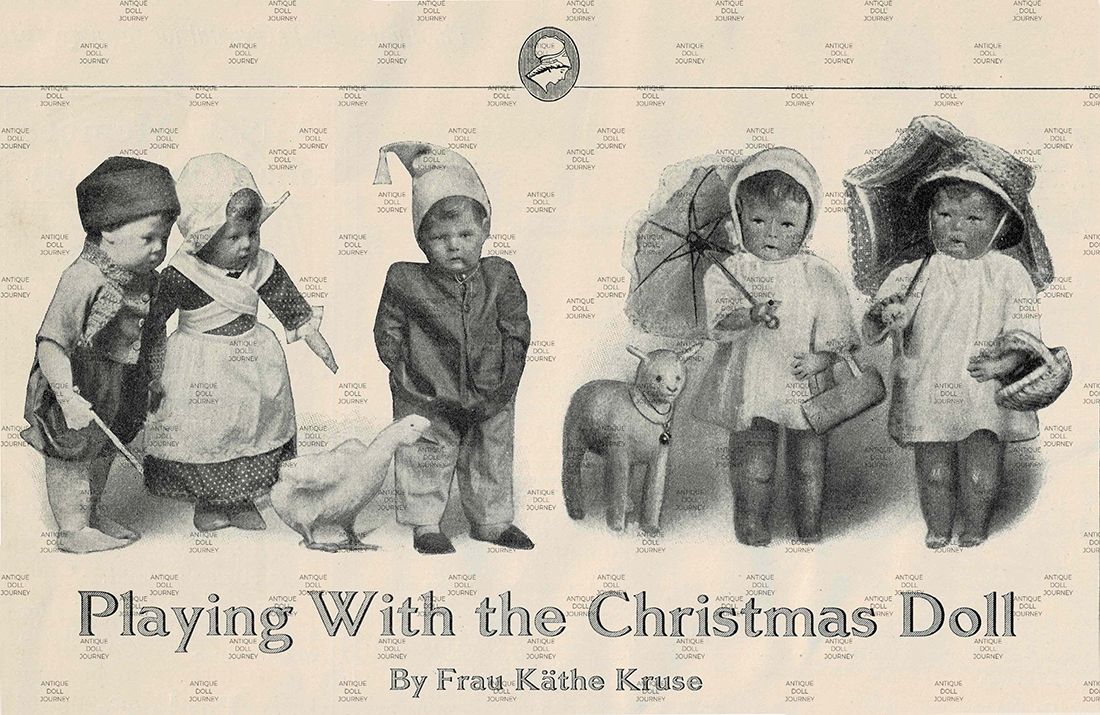Käthe Kruse Dolls – the Beginnings
American newspapers called Kathe Kruse of Koesen, Germany, a maker of wonder dolls. In 1914 her handmade dolls were known the world over as the finest imitation of living children that had yet been achieved. She exhibited her first doll in 1910 at the toy fair known as “The Messe” in Leipzig held each March during that time.
Royal families of Europe and millionaires in America had Käthe Kruse dolls in their children’s nurseries bearing her signature on the left foot of each doll. She strove to make the dolls an education toward motherliness, as she described her art to an American buyer back in 1914.
Youngest Kruse Child Modeled for the Doll
In 1924 the German publication Ost und West ran another illustrated story of the dolls with scenes of the dolls once again acting out fun scenes of real life. In the story readers learn that Käthe made her first dolls for her three daughters using sewn sand filled towels. Her husband Max Kruse had refused to buy traditional dolls for their children.
The story claims her success came at the Berlin Exhibition called “Spielzeug aus eigener Hand“ (handmade toys) in 1910. Dolls were stated to be 43 cm tall but with the fall of the German mark she began making a doll only 35 cm tall. The reporter wrote the dolls were made of water dense nettle material. Then thinking of girls between ages of 10 to 14 who enjoyed making clothes for their dolls, she decided to create the small 20 cm Bambino doll.
Interestingly the story reveals that Kruse’s youngest child or youngest son served as a model for the doll. This helps us understand why many claimed common doll of the time became a very sweet, true-to-life and tender child thanks to Käthe Kruse (1883–1968) of Koesen, Germany (Coburger Zeitung. 29 November 1928).
Her Workshop: a Well Guarded Secret
A reporter explained then they were 17 inches high dressed in individual typical childlike costumes. Even more each painted face was different with no two countenances alike. Making the dolls in her red brick home, even in her children’s nursery, the process by which she made them was a well-guarded secret in 1914. The dolls were very expensive.
But readers learn in 1923 from the German paper Münchner neueste Nachrichten the manufacturers stuffed the fabric Kruse doll bodies with deer hair, but the heads were stuffed with cotton wool.

Dates of Different Kathe Kruse Dolls
- First Model in 1910
- Schlenkerchen or “The Toddler” in 1922
- Träumerchen or “Little Dreamer” in 1925: a life-sized weighted baby
- Kleine or “Little One” (1928)
First Kathe Kruse Doll Catalogs
At that time she did very little advertising but created a catalog with half tone photos of the dolls as they might be at play in a doll nursery, in high chairs, with balls, with favorite animals, in benches at school, washing and ironing. It was these very pictures that introduced the dolls to the world in media which is linked and described below.
Expensive Dolls
In 1914 A dressed Kruse doll cost $9.89 at Macy’s in New York. Later in 1925 a 17 inch doll sold for $4.95 in Washington DC.
Käthe Kruse Dolls Appear in the Media
Deutsche Kunst und Dekoration
Original Käthe Kruse handicrafted fabric stuffed dolls appeared in photographs in the November 1912 edition of the German magayine Deutsche Kunst and Dekoration. One of the photos included two dolls dressed in handbatik Russian outfits with matching bonnets. Her dolls appear again in Deutsche Kunst und Dekoration in 1915 in German military uniforms and play scenes of war. Information under the photos give the location of Käthe Kruse at Bad Kösen.
Dolls for the Soul of the Child
The next year her dolls appeared in Dekorative Kunst (1913) along with images of dolls made by Marion Kaulitz of Munich and Margarete Steiff in an article entitled, “Kind und Kunst in Frankreich.” Remarking about exhibits on display at the Musee Galliera in Paris The writer complains that the French art encourage young children too early in age to act like grownups. Then it turns and complains of how the French write about getting rid of German dolls, how German dolls have no expression. (One can’t help but sense the tension between the French and the Germans at the time.) One paragraph says it all which translated reads thus:
“What would such a fatherland saver and moral policeman want to put in the place of a robust, heartwarming Munich doll, a Nuremberg plush toy? Maybe the doll that was on display, in a ball gown with a cinched waist, adorned with jewelry, a heron feather on the undulating wig? What delusions such people are caught up in! No one reacts more violently, more honestly, more mercilessly to art than a child.”
Dekorative Kunst. 1913/14. p 146.
The writer of the article makes no mention of the dolls presented in the photo as if they exists for the reader to decide comparing the adult like French figurines in a set of photos to the German childlike doll figures of Kruse, Kaulitz, and Steiff in the others. The words make the implication of what one concludes.
Yet the article concludes taking away any boast the French or Germans could make by showing how the child in the desire to play can outsmart any child or art teacher by making a toy out of piece of cardboard which he will enjoy immensely!
January 1914 Ladies Home Journal

Käthe Kruse dolls appeared along with a story written by her in the Ladies Home Journal in 1914. The story “Playing with the Christmas Doll” Kruse describes the dolls in play like scenes. The appear to attend school, chat with friends, and dress for the day. She called some of the dolls by name like Hans, Gretchen, and Michel. At the bottom of the page they claim the dolls were manufactured of waterproofed material which was colored to a natural flesh tint. Anyone interested in the dolls could make inquiries with the editors of Ladies Home Journal.
Christmas 1915 Window Displays
A German newspaper in 1915 reported on the Christmas displays full of toys while including a mention of the magnificent toy dolls with their full-of-life faces by Käthe Kruse.
Various Interesting Facts
Käthe Kruse Makes Toy Soldiers
At the encouragement of her husband, she began making toy soldiers. Photos of the soldiers in battle ground arrangements appear in the Deustche Kunst und Dekoration in 1915. She claimed it was not easy but got ideas for a photograph of an unknown soldier. Kruse admitted in the article to the difficulty of the task. She did not wish to talk about it. An ad later in the publication displays the fabric stuffed dolls in uniform and mentions the dressed dolls cost between 30 and 40 marks. Buyers could request for catalogs and find the dolls at relevant shops or the Käthe Kruse workshop in Bad Kösen, saale 1.
Kathe Kruse Exports to Spain
In 1923 Export-Nachrichten announced that her dolls could be found in Spain.
Kathe Kruse at F. A. O. Schwartz
Charlotte Garrison wrote in 1926 that the most Käthe Kruse’s dolls, though expensive, had artistic value with exquisitly modelled and painted faces. She wrote the dolls came in several sizes and patterns and most represented children at age three and fours years. She included a photo of a girl named Olivia in a preschool playing with a Käthe Kruse doll. In the photos you also see a Schoenhut and a Martha Chase doll in the classroom.
She provided the address of F. A. O. Schwartz Toy Store on 303 Fifth Avenue, New York as a source for the Käthe Kruse dolls.
Kathe Kruse Ad in 1928 German Spielwaren Zeitung.
Käthe Kruse advertised softly stuffed dolls described as unbreakable, durable and washable without fading made entirely of waterproof muslin. The company advised buyers to wash only with soap and water without rubbing. Buyers could request catalog and prices from: COMPANY KÄTHE KRUSE BAD KÖSEN 22/Alemania 9.
Kathe Kruse Book Publications
In 1929 Käthe Kruse had a book published “Bei Spiel und Sport” (Playing Sports, A New Picture Book).
Later in 1932 her dolls appear in the illustrations of a story by Sophie Reinheimer, “O Fritz – Wohin sind wir geraten!” (Oh Fritz – where have we gotten to!)
1932 Kathe Kruse Doll Look-a-Likes
The Neustadt Doll Company manufactured in 1932 a “Princess Sibylla” doll based on Käthe Kruse dolls. (Princess Sibylla, a granddaughter of Queen Victoria).
The Käthe Kruse Doll Museum
One can visit the Käthe Kruse Doll Museum in Donauwörth, German (the capital of the Donau-Ries district in Swabia, Bavaria). The museum exists inside the former Capuchin monastery with an address of:
Käthe-Kruse-Puppen-Museum
Pflegstraße 21 a
86609 Donauwörth
